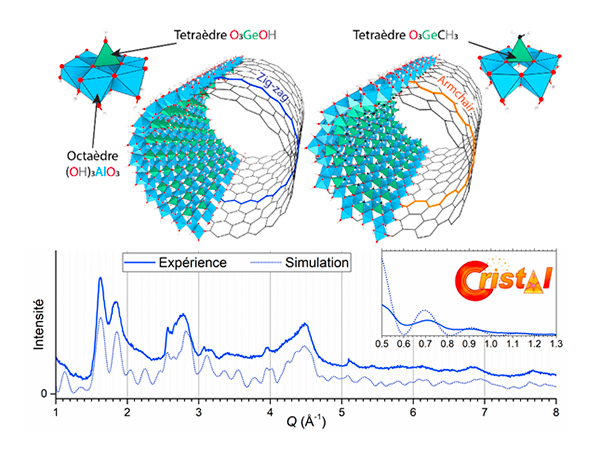“Nanotube” and “butanone”, “small” and “malls”, “atom” and “moat”: these anagrams illustrate how meaning comes from the association of the letters of the alphabet. In the same way, the properties of matter derive from its structure at the atomic scale, that is, the nature of the constituent atoms and their organization.
Researchers from the Laboratoire de Physique des Solides in Orsay proposed a simple methodology to characterize a complex tubular structure from wide angle X-ray scattering diagrams obtained on the CRISTAL beamline at SOLEIL.
Single-walled inorganic nanotubes are hollow cylinders of nanometric diameter with exceptional properties in fields as diverse as nano-electronics, nano-fluidics, nano-catalysis and molecular sieving. Yet, the structure of the nanotubes formed of at least three types of atoms remains elusive, which hinders the understanding and control of their properties. How are the atoms organized within these nanotubes?
X-ray scattering is a technique of choice for studying the organization of matter but the nanometric lateral size of the objects considered here is a strong limitation. Indeed, it implies that scattering diagrams are mainly composed of broad peaks, giving access to a very limited number of structural parameters. By considering helicoidal symmetries and by minimizing a semi-empirical energy, the determination of a complex tubular becomes realistic because it is reduced to the evaluation of a few geometric parameters.
This methodology is applied to nanotubes of the ‘imogolite’ type, which can be synthesized with adjusted functionalities. These nanotubes are considered in a geological context for the storage of carbon, metal cations or radionuclides in soils, where they are naturally present, or even as markers of the evolution of the Martian climate. Our methodology allowed us to determine the positions of the atoms of such nanotubes. Fitting X-ray scattering diagrams obtained on the CRISTAL beamline, an original rolling mode is evidenced for methylated imogolite nanotubes of nominal composition (OH)3Al2O3Si(Ge)CH3. The elementary cell formed of (OH)3AlO3 octahedrons and of a O3Si (CH3) -or O3Ge(CH3) tetrahedron - rolls on a cylinder forming an ‘armchair’ structure, while the rolling mode is ‘zig-zag’ for hydroxylated nanotubes.
The transferability of the approach opens up for improved understanding of structure-property relationships of inorganic nanotubes, to the benefit of fundamental and applicative research in these systems.

Figure: Structure and rolling mode of a hydroxylated imogolite nanotube with nominal composition (OH)3Al2O3GeOH and of its methylated counterpart (OH)3Al2O3GeCH3. Comparison between experimental wide angle X-ray scattering diagrams obtained on the CRISTAL beamline and the simulated one, for a powder of methylated alumino-germanate nanotubes.
